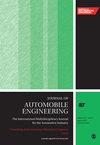Numerical and experimental investigation of vibration and response optimization of a car chassis with effect of changing driving speed
IF 1.5
4区 工程技术
Q3 ENGINEERING, MECHANICAL
Proceedings of the Institution of Mechanical Engineers Part D-Journal of Automobile Engineering
Pub Date : 2024-07-25
DOI:10.1177/09544070241264867
引用次数: 0
Abstract
Vibration of automobile vehicles is the important issue in the entire vehicle design process as it affects the comfort level and the overall image of a vehicle, an experimental evaluation and prediction of vibration level of the vehicle in stationary and driving conditions are often necessary. This paper delves in to a numerical and experimental investigation of vibration and response optimization of a car chassis with peak acceleration and peak amplitude level of vibration as a response parameter in vertical motion. These response parameters were obtained numerically by developing a mathematical model of car and equation of motion. Newmark Beta method used to solve the equation of motion to get the values of response parameters in MATLAB software. For the experimental investigation of the response parameters a car with monocoque chassis, three cylinder engine, Macpherson front suspension and twist beam rear suspension with coil spring considered and FFT analyzer used for the data collection of the response parameters, FFT analyzer works on the fast Fourier transform algorithm. Comparative analysis between the numerical and experimental investigated values of response parameters shows the minimum error of 0.6035% and average error of 2.81% at various points on chassis; it shows the precision of the mathematical model and practical car model. To optimize the performance index of response parameters Fractional factorial design of experiment (DOE) method applied with six factors and two levels. The main effect analysis, analysis of contribution, analysis of variance and backward elimination method were applied in fractional factorial design. Regression equation for the response parameters were obtained with two level six factor fractional factorial design for the vibration level prediction. The comparative analysis of the response parameter levels before and after the optimization shows the reduction of 65.61% in peak acceleration level and reduction of 17.70% in the peak amplitude level of a car chassis with respect to change in the driving speed. The design and optimization method proposed in this study has a significant effect on the vibration reduction of the car chassis which provides a reference for the optimization of the vibration level to improve the performance of car suspension.汽车底盘振动和响应优化的数值和实验研究与行驶速度变化的影响
汽车振动是整个车辆设计过程中的重要问题,因为它会影响车辆的舒适度和整体形象,因此通常需要对车辆在静止和行驶条件下的振动水平进行实验评估和预测。本文以垂直运动中的峰值加速度和峰值振幅作为响应参数,对汽车底盘的振动和响应优化进行了数值和实验研究。这些响应参数是通过建立汽车数学模型和运动方程数值求得的。在 MATLAB 软件中使用纽马克贝塔法求解运动方程,以获得响应参数值。在响应参数的实验研究中,考虑了一辆采用单体底盘、三缸发动机、麦弗逊前悬架和螺旋弹簧扭转梁后悬架的汽车,并使用 FFT 分析仪收集响应参数的数据,FFT 分析仪采用快速傅里叶变换算法。响应参数的数值和实验调查值之间的对比分析表明,底盘上各点的最小误差为 0.6035%,平均误差为 2.81%;这表明数学模型和实际汽车模型的精确性。为优化响应参数的性能指标,采用了六因素两水平的分因子试验设计法(DOE)。在分数因子设计中应用了主效应分析、贡献分析、方差分析和反向消除法。通过两级六因子分数阶乘设计得到了响应参数的回归方程,用于振动级别预测。对优化前后响应参数水平的对比分析表明,随着行驶速度的变化,汽车底盘的峰值加速度水平降低了 65.61%,峰值振幅水平降低了 17.70%。本研究提出的设计和优化方法对汽车底盘的减振效果显著,为优化振动水平以提高汽车悬架性能提供了参考。
本文章由计算机程序翻译,如有差异,请以英文原文为准。
求助全文
约1分钟内获得全文
求助全文
来源期刊

CiteScore
4.40
自引率
17.60%
发文量
263
审稿时长
3.5 months
期刊介绍:
The Journal of Automobile Engineering is an established, high quality multi-disciplinary journal which publishes the very best peer-reviewed science and engineering in the field.
 求助内容:
求助内容: 应助结果提醒方式:
应助结果提醒方式:


